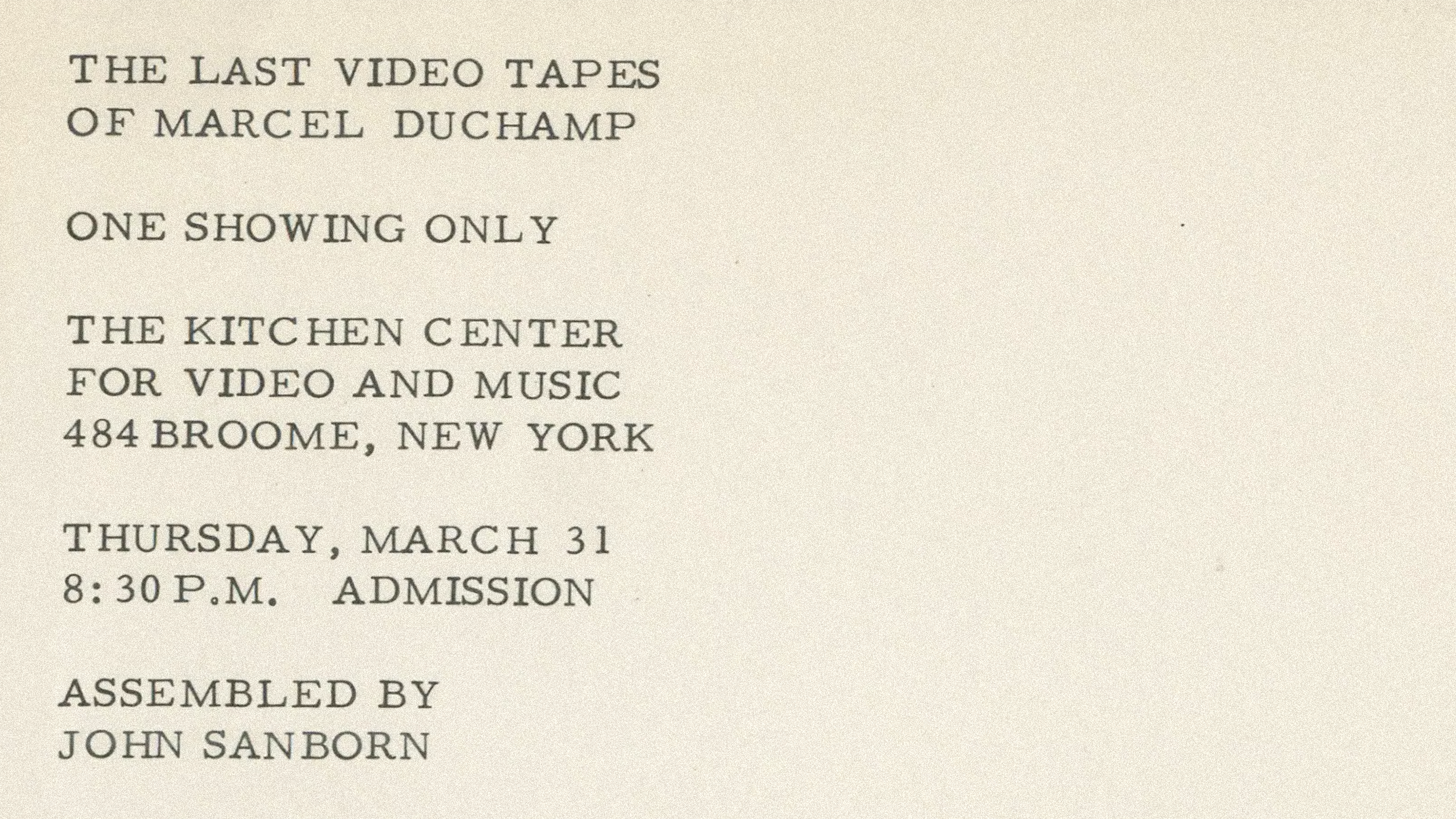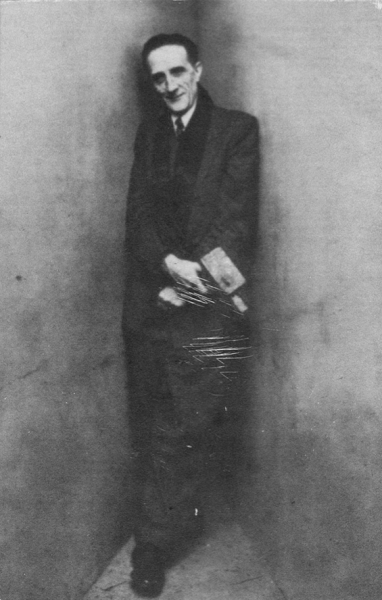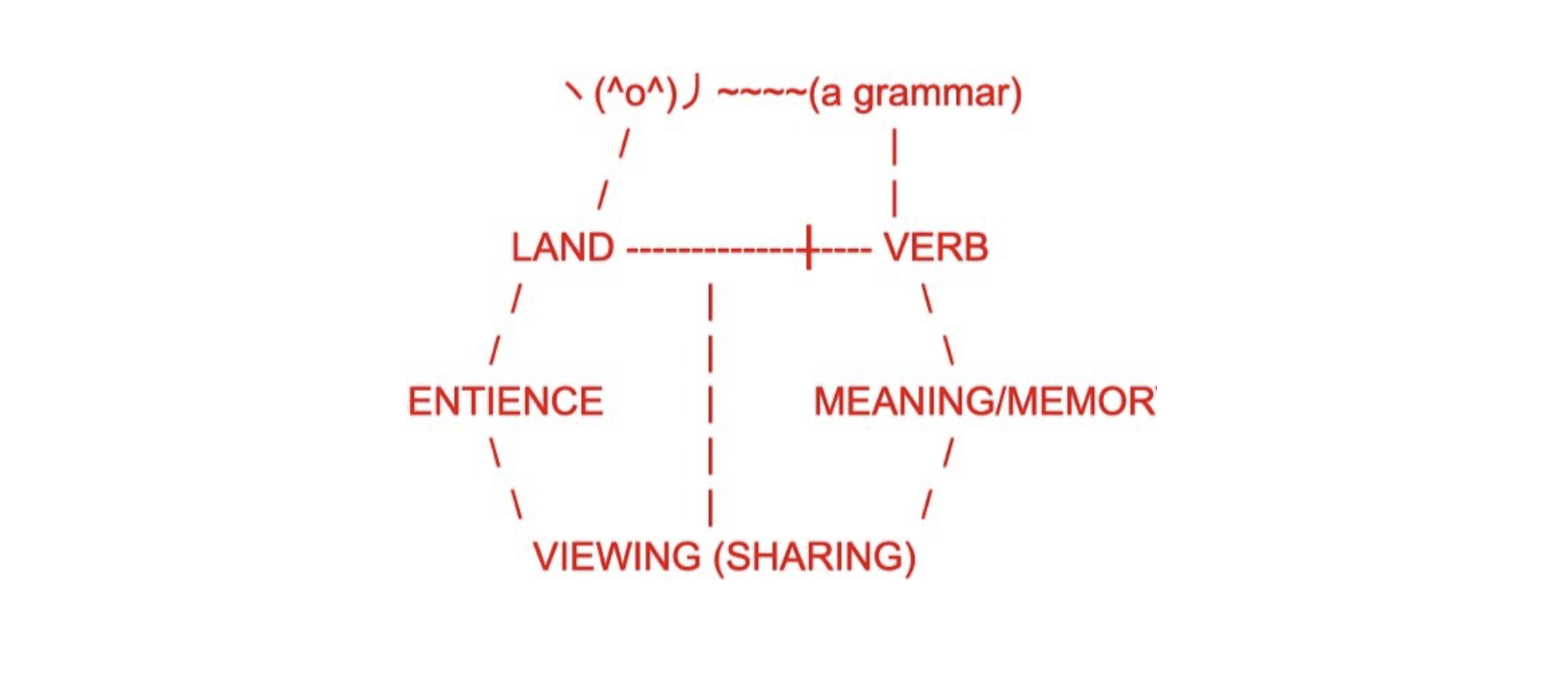
Credits:
By Cole Gruber, Fall 2017 Curatorial Intern
September 8, 2017
To what extent does Marcel Duchamp figure into a narrative of The Kitchen’s history? That was the first question that came to mind when I was told I could contribute a post to The Kitchen’s blog, home to announcements and short essays from its curators and ruminations like these from its interns. While discussions of Duchamp may be old hat for many, he is nevertheless the proverbial Rome of my thinking about art and its history—all roads lead to him.
In a sense, The Kitchen owes almost everything to Duchamp, but only in the rather banal way that most art spaces dedicated to presenting work from the last fifty years or so do too. A quick look at The Kitchen’s past programming and one sees an esteemed history of experimentation in what art historian and theorist Thierry de Duve calls “art in general”—art that gets to be called art without simultaneously being a Salon medium, namely painting or sculpture. It is true that today “video” and “performance” are often presented as specific mediums in their own right—i.e. they have histories that can be called upon and conventions that can be grappled with in order to create new forms—but this was not always the case. Performance and video used to reside on the very outer limits of acceptable art practice, and if an early video work was art, then it was not by virtue of its productively engaging in the history of the video medium—for there was no established historical medium with which to engage—but rather because the video was, well, art! Such an aesthetic inclination—to call something art that has no real formal link to the history of a specific medium—did not exist before Duchamp, who could be said to have inaugurated the “art in general” system with his readymades. Indeed, an object like Fountain is neither a painting nor a sculpture—it is art or it is nothing at all. It thus seems inarguable that the collective art world consciousness that allows a video or a performance piece to be called a work of art—to join the ranks of the Mona Lisa, David, and Starry Night—is directly attributable to Marcel Duchamp’s life and works. Consequently, The Kitchen’s place as a leading venue for video and performance is as well.
But as I said, I was not particularly interested in that angle. Rather, I yearned to discover if there were any direct engagements with Duchamp and his legacy at The Kitchen. And as it turns out, there have been.
In 1975, the contemporary music group S.E.M Ensemble gave four concerts at The Kitchen, one of which included three pieces by Duchamp, all conceived around 1913. Musical Sculpture initially existed only as a note on paper, placed in Duchamp’s 1934 Green Box, which read, open-endedly: “Musical Sculpture. Sounds lasting and leaving from different places and forming a sounding sculpture that lasts.” Erratum Musical was written for three voices—Duchamp and his two sisters Yvonne and Magdeleine—by jotting musical notes on cards and then drawing them at random from a hat. The Bride Stripped Bare By Her Bachelors, Even: Erratum Musical (2) also relied on chance procedures: 85 balls, each bearing a pitch, were to be rolled out of a funnel from a bridge and into a group of moving, open-roofed cars below. This process should be repeated eight times to create the base composition and then transferred onto, per Duchamp’s instruction, “[a] player piano, mechanical organs or other new instruments for which the virtuoso intermediary is suppressed." Duchamp himself never realized this work, but composer and flautist Petr Kotik, the director of the S.E.M Ensemble, built the described apparatus and produced a composition for both player piano and an ensemble of alto flute, trombone, glockenspiel, marimbaphone, and celesta.
In 1984, The Kitchen presented Japanese artist Shigeko Kubota’s Duchamp’s Grave (Revived). For the installation Kubota stacked twelve video monitors on top of each other floor to ceiling, each showing footage of her visit to Duchamp’s grave in Rouen, France. In the shaky video— which Kubota attributes to both the emotional weight of the cemetery and the physical weight of the heavy Sony Portapak—the artist can be heard repeating the mournful refrain “Marcel Duchamp, 1887 to 1968.” On The Kitchen’s floor, Kubota placed a long strip of mirrors, serving to both multiply the video images in an infinite regress and form a surface reminiscent of reflective pools found at the memorial sites of important persons.
Kubota’s installation and the S.E.M. Ensemble’s concert evince both the respect Duchamp has rightfully earned and the sublime originality of his creative output. Indeed, using the vagaries of chance and written instruction in place of creation predate by half a century the work of those generally considered to be the first to use such methods in music. But there is perhaps no better window into the world the artist wrought than the events of March 31 and April 1, 1977.
The summer before, the young artist John Sanborn was lamenting the fact that Duchamp, despite the prodigiousness of his artistic career, had never ventured into the domain of video art. Though he had lived to see the development and introduction into market of the first Sony Portapak in 1967, the instrument was never graced, as far as art historians can be sure, with a Duchampian touch. But what if it had been? What if Duchamp was counted amongst the first video artists? Surely his videotapes would hold some sort of artistic value—or perhaps not, as Sanborn ultimately implies.
In the absence of any actual Duchampian video, Sanborn decided to take matters into his own hands by presenting videos under Duchamp’s name to the public. Using by-then outdated equipment, he shot four twenty-minute tapes in and around the late-Duchamp’s Greenwich Village neighborhood. Through thoroughly—and probably purposefully—blurry video, the tapes revealed myriad relatively unexciting—or as Sanborn put it, boring—sights: various household objects, unrecognizable pedestrians on the street, crime notices posted on telephone polls, the decor of the Marshall Chess Club (a frequent stomping ground of Duchamp’s when he purportedly gave up art to pursue chess), and, with the permission of Duchamp’s widow Alexina, a book of notes dedicated to Étant donnés, the artist’s final opus. One tape also included, purely by accident, a brief shot of a Ford Pinto, an automobile first produced in 1971. That passing anachronism aside—one Sanborn had intended to expurgate but ultimately did not for lack of time—the tapes appeared plausibly genuine, as if they really could have been produced by a curious Duchamp in the first year of the Portapak’s existence.
After getting the go-ahead by then-director of The Kitchen Robert Stearns, Sanborn gave the videos an added veneer of authenticity by introducing them with a taped, canned speech given by artist Russell Connor—a co-conspirator in the hoax—which talked of video experiments at Bell Labs, the acquisition of early Sony Portapacks, and equipment ultimately making its way into the hands of Duchamp, whose tapes were found at the bottom of a box in the artist’s old studio. Sanborn also included a genuine 1964 interview between Connor and Duchamp, held at Boston’s Museum of Fine Arts on the occasion of an exhibition by Jacques Villon (Duchamp’s brother). The Kitchen supported this project not only by agreeing to present the tapes, but also by producing and distributing promotional materials: posters and postcards bearing the title “The Last Video Tapes of Marcel Duchamp” and a doctored photo of the artist with his back to a corner, smirking at the camera, and holding an old Portapak. The tapes Sanborn was ready to air thus seemed perfectly legitimate.
More than 600 people funneled into The Kitchen over the course of the two nights to watch what Sanborn produced, leaving half as many out on the street for lack of space. If we are to believe Sanborn and local newspapers, then it seems as if many—if not most—were entirely unaware of Sanborn’s fraud. There had been initial skeptics before the tapes were shown, of course, but when they called The Kitchen to investigate the authenticity of the find, they were told by Eric Bogosian, then assistant to Stearns, that the tapes were genuine. Moreover—and this is crucial—what Sanborn had shot under Duchamp’s name was not particularly different from much of the early experiments with portable analog video that ran rampant in the late 1960s. It was thus perfectly reasonable to be duped. Nevertheless, I am confident that this institutionally supported hoax bespeaks a larger issue still prevalent in the art world today, one that needs to be accounted for.
Sanborn and co. defended themselves after their fraudulence was revealed by claiming that Duchamp would have approved—that is, that their actions had been laced with Duchampian duplicity from the very beginning. Indeed, there are deep parallels—deeper than perhaps even Sanborn realized—between this hoax and Duchamp’s own epoch-making one at the 1917 exhibition of the Society of Independent Artists, where Duchamp had tried to exhibit under the name of unknown artist R. Mutt a urinal he dubbed Fountain. The likeness between the events does not begin and end with presenting one’s own work using a false name; rather, in both cases, the artists were subjecting their audiences to a test. Duchamp submitted to the Independents an object that he demanded be entered into the exhibition because he—or R. Mutt at any rate—had paid the necessary dues. The gesture tested the Independents’s willingness to adhere to their own rules—i.e. that anyone who paid was free to exhibit in the show. Sixty years later, Sanborn, who claimed to be “infuriated” by the prevalence of granting legitimacy to “anyone making video and calling themselves a video artist [even] when their work stunk,” tested the ability of The Kitchen’s audience to see past a scam, to realize that not all video is worthy of artistic legitimation. In essence, Duchamp dared those who beheld his urinal to call it a work of art, while Sanborn dared those who watched his videos to call them junk. In both cases, the audiences erred.
I would argue that these two instances of misjudgment speak to the disparity between a pre- and post-Duchamp art world. When a urinal can count as a work of art, practically anything can. And that’s all well and good—and I never doubt the brilliance and importance of Duchamp as an artist—but there are practical upshots to a general culture of permissiveness and credulity: a tendency to default to important names and institutions in place of a healthy dose of skepticism and critical awareness in one’s dealings with art. If genuine, would these tapes have garnered any attention at all or be considered bearers of artistic value if they weren’t presented at The Kitchen and under Duchamp’s name? I would think not. And while that is not necessarily worthy of derision or a problem to be solved, it is something that demands constant awareness—the recognition of a contemporary condition of art production and discourse. Without Duchamp, there is no Sanborn; without Fountain, there is no The Last Video Tapes of Marcel Duchamp. This is more than a truism, more than the self-evident fact that Duchamp needed to have lived in order to present forged work under his name. Rather, this is a matter of art historical sea change. For better or for worse—but probably just for different—Duchamp transformed the way artists create art, viewers view art, institutions present art, and art writers write about art, and that fact must be present in the minds and work of all those who seriously engage with art produced in the last century.
Postscript
There are those who consider all of Sanborn’s actions—all that went into producing and showing The Last Video Tapes of Marcel Duchamp—to be part of a work of art in its own right, a hoax doubling as a combined video and performance piece. Of this I am unsure and remain wary—the life and legacy of Marcel Duchamp has taught me that such skepticism is always warranted.
Image: 1) Postcard for John Sanborn, The Last Video Tapes of Marcel Duchamp, March 31, 1977 at The Kitchen, front. To view the full postcard, click here.


